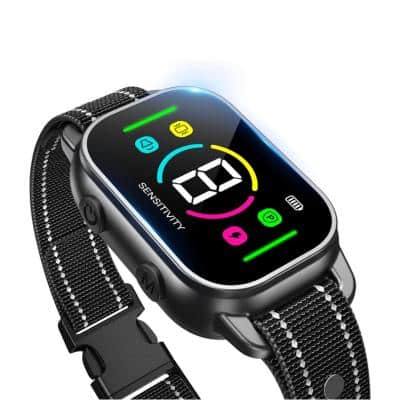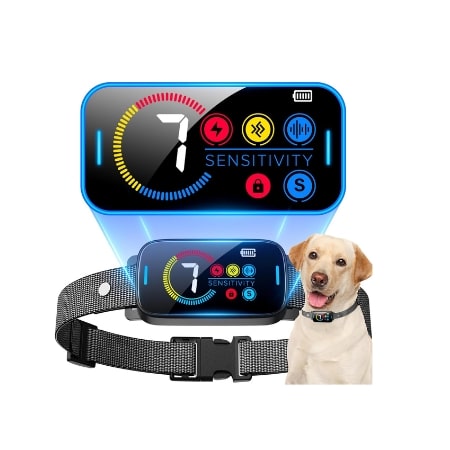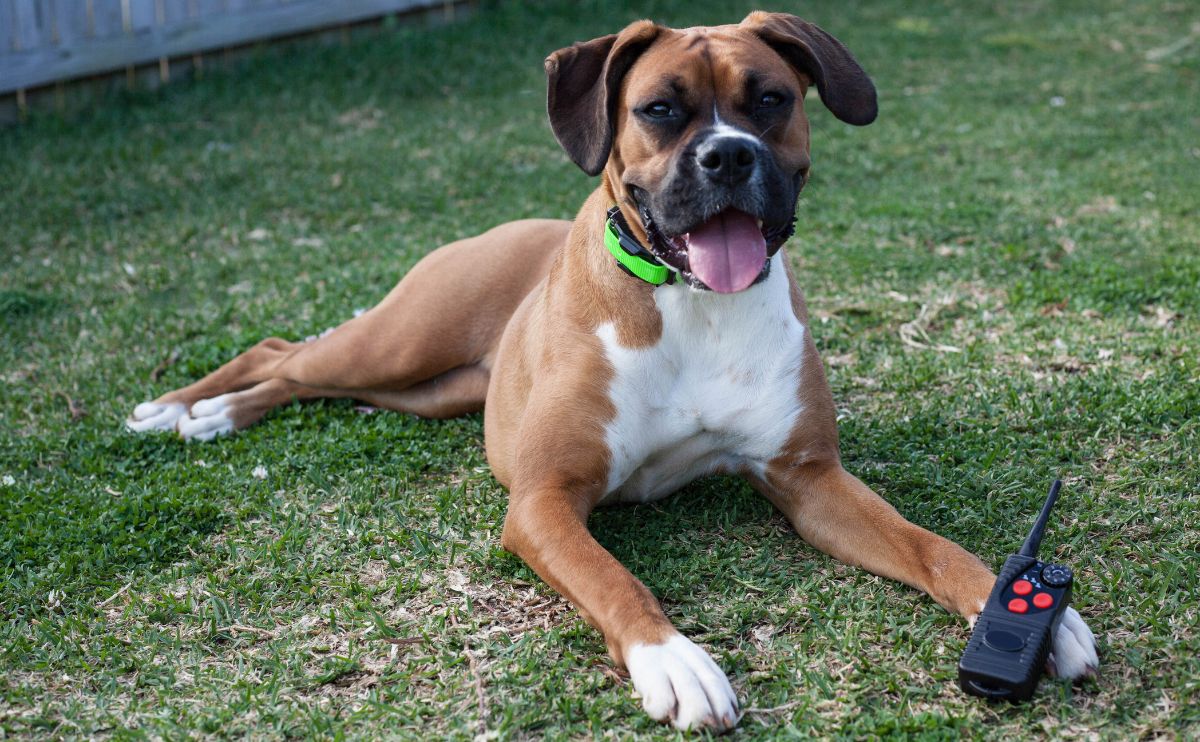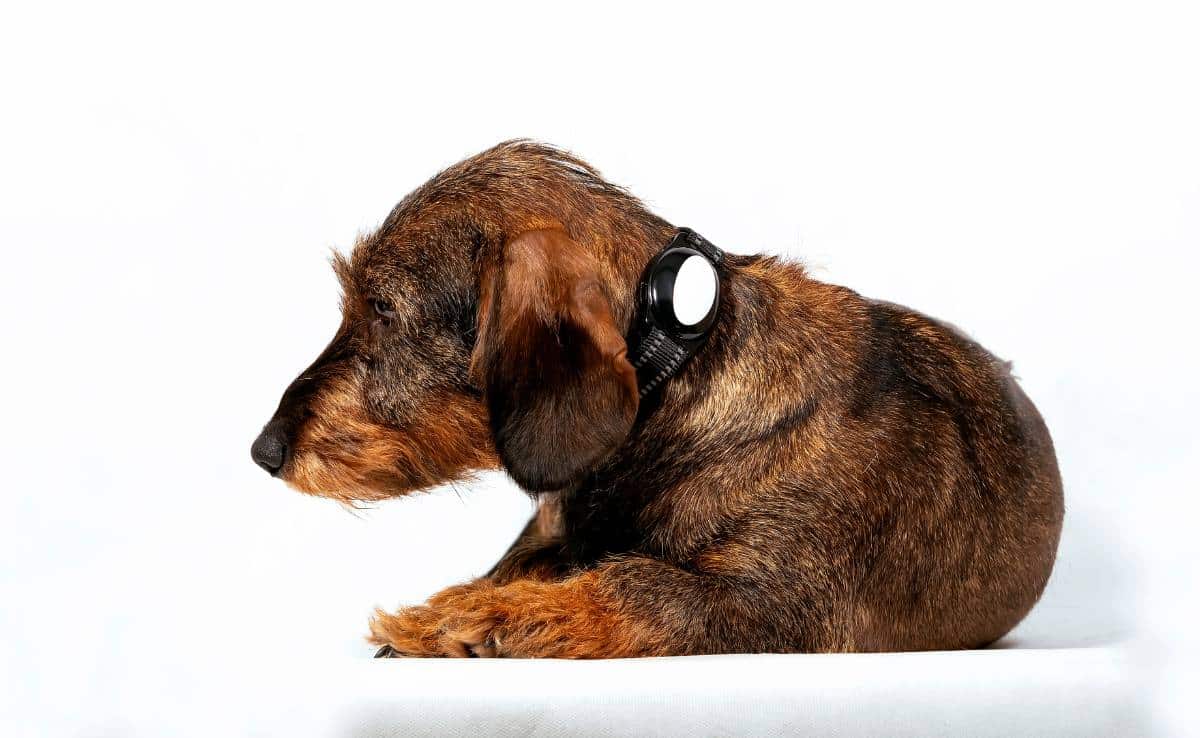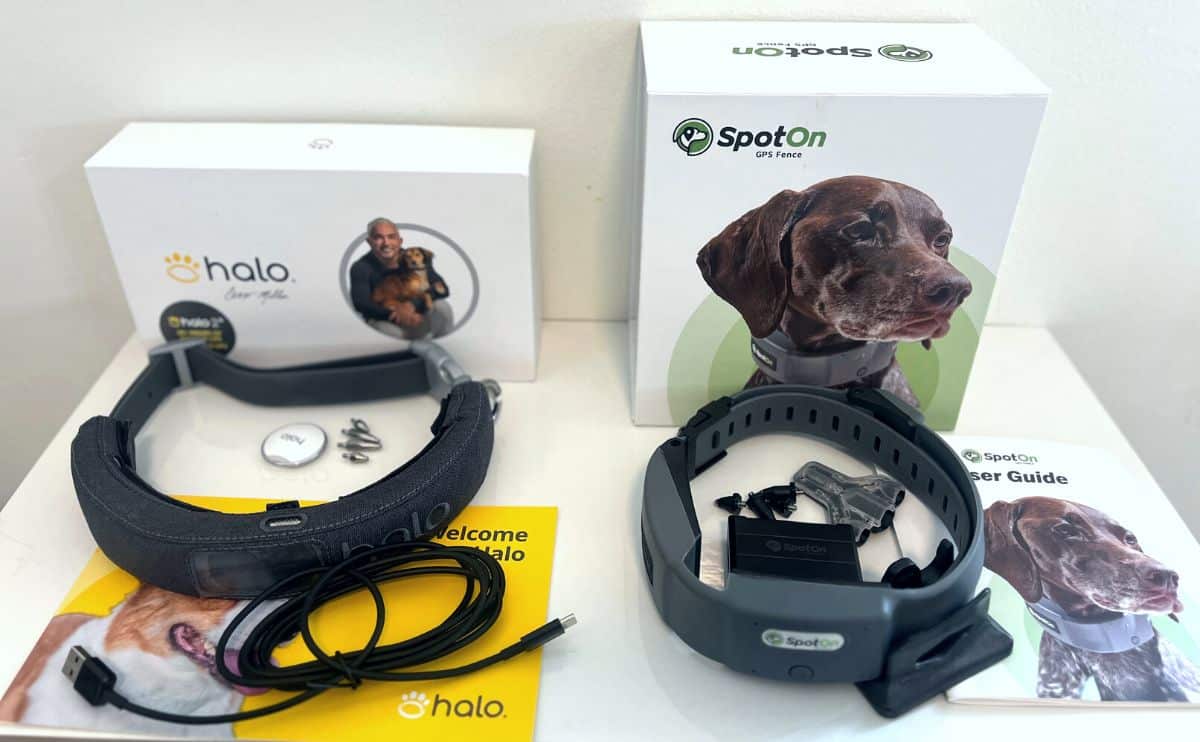7 Best Dog Bark Collars & Alternatives For Small, Medium, Large, & Stubborn Dogs
When you purchase through links on our site, we may earn a commission. Here’s how it works.
Does nearly everything set your dog off into a barking frenzy? While some barking is normal for our furry friends to communicate with us, many dogs develop a problem with inappropriate or excessive barking. If you’re at your wit’s end, using a bark collar along with proper training may be just what the doctor ordered for your peace of mind and your neighbors, too. I’ve researched dozens of no-bark collars and give you my top picks to help you narrow your choices.
Table of Contents
| Overall | No-Shock | Small Dogs | Large Dogs | Stubborn Dogs |
|---|---|---|---|---|
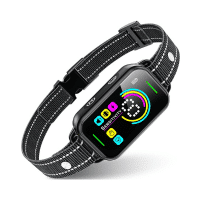 |  |  | 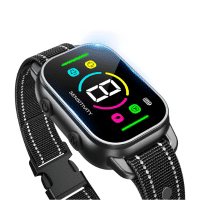 | 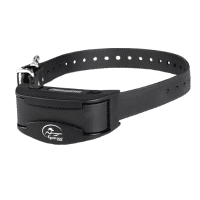 |
| DINJOO | DogRook | Petdiary | NHUJK | SportDOG |
| View on Amazon | View on Amazon | View on Chewy | View on Amazon | View on Amazon |
| Read Review | Read Review | Read Review | Read Review | Read Review |
Our top picks for this article mainly include automatic bark collars. If you’re looking for a training collar that allows you to deliver corrections at your discretion via a handheld device, see our reviews of the best remote training collars.
5 Features To Consider In An Anti-Bark Collar

Knowing what to look for when picking the best no-bark dog collar for your pooch is essential. Not every bark collar is the same, and you need to think about what you want from the no-bark collar. Below is my quick buyer’s guide on what to look for when shopping for one.
- Bark Detection. Some collars have special bark detection technology that allows the device to distinguish between your dog’s bark and other noises, including other dogs barking. This is especially important for multi-dog households.
- Training Modes. Bark collars use three main training modes to alert your pup to stop barking: beep, vibration, and static stimulation (also known as shock collars). Some collars have all three, with static shock typically being optional. Others only use non-shock correction, while some use only static stimulation.
- Sensitivity Levels. Most bark collars allow you to adjust the sensitivity level with each training mode. You can select the beep volume and the strength of the vibration or shock. The more sensitivity levels, the better. This gives you multiple options depending on your pup’s temperament and how they respond to the correction method.
- Battery Life. You want to ensure you get a collar that doesn’t need frequent recharging. Otherwise, it becomes a chore, and your pup might become frustrated with its inconsistency.
- Waterproof. If you want to use your bark collar outdoors, a waterproof collar is ideal for rainy days.
Safety Advice
Experts advise never leaving a bark collar on your dog for more than 12 hours at a time. Be sure to check your dog’s skin daily and clean the neck often to avoid irritation.
5 Best Bark Collars For Dogs
I’ve chosen my top picks based on several factors, including performance and reliability, features, customer feedback, pricing, and more. I also categorize my winners to help you find the best bark collar for your specific needs.
Best Dog Bark Collar Overall: DINJOO Bark Collar Review
View on Amazon | View on Walmart
The DINJOO smart bark collar gets overwhelmingly positive reviews from happy pup parents. What makes this collar so effective? It contains a smart chip that detects your dog’s bark and vocal chord movement. This advanced technology eliminates the problem that many bark collars have of issuing false corrections due to nearby noises. It is also IP67 waterproof, which makes it suitable for outdoor use, and it is available in five colors: black, blue, green, orange, and purple.
The adjustable collar fits most dogs (6-27 inches in neck size or 8-120 pounds) and has four training modes: beep, vibration, beep + vibration, and beep + vibration + shock. The use of shock is entirely optional. And eight levels of sensitivity settings allow for progressive training. It also has a large LED color display screen that’s easy to use and read. With a reliable and effective performance on top of a competitive price, this collar may be the answer to your dog’s barking problems.
| Pros | Cons |
|---|---|
| Uses smart bark recognition and vocal chord motion detection | It may be a bit bulky for small dogs |
| Easy to use with a large LED screen | A few reports that it delivers correction with barking from nearby dogs |
| 4 training modes and 8 sensitivity levels | |
| USB rechargeable battery life up to 15 days | |
| Automatic safety shut-off mode for excessive barking | |
| It comes with 2 sizes of protective silicone prong sleeves to protect your pup’s skin | |
| IP67 waterproof | |
| Many users say it’s highly effective without having to use the shock setting |
Price
- Starting at $33.09
Best No-Shock Bark Collar: DogRook Dog Bark Collar Review
View on Amazon | View on Walmart
Although shock mode is optional with many bark collars like the DINJOO, you may prefer to purchase one that only has sound and vibration corrections if you’re worried about accidental shocks. I recommend the DogRook collar as your best no-shock bark collar option. With an easy-to-adjust and lightweight design, it fits pups 8 to 110 lbs or up to 22 inches in neck size. However, several customers said it was too big for their small dog. So, it’s likely a better fit for dogs over 12 pounds.
DogRook features a smart microphone that recognizes your furry friend’s unique bark to deliver an automatic and instant correction. It has two vibration modes, seven sound stages, and five sensitivity levels you can adjust for environmental noise. While many customers said it’s effective, some complained that it gives false corrections for nearby dogs barking. And sound and vibration only aren’t always enough to curb stubborn barking. DogRook is available in four colors: black, blue, pink, and orange.
| Pros | Cons |
|---|---|
| It uses a smart microphone that detects your dog’s unique bark | It doesn’t fit dogs with neck sizes over 22″ and is not ideal for dogs under 10 pounds |
| It only uses sound and vibration | Several reports that it delivers false corrections from other dogs barking |
| 5 sensitivity levels | Some complaints that the buckle pops open |
| Durable nylon fabric and cute design | |
| USB rechargeable battery life up to 14 days | |
| Waterproof (but unknown IP rating) | |
| It comes with 2 sizes of protective silicone prong sleeves |
Price
Best Bark Collar For Small Dogs: Petdiary B330 Dog Bark Collar Review
View on Chewy | View on Walmart
This lightweight, slender, and high-quality bark collar fits neck sizes as small as five inches, making it our top pick for small dogs. It’s also suitable for dogs up to a 24-inch neck size. It features three training modes: one tone, seven vibration levels, and seven static stimulation levels. It also has an automatic shut-off mode for excessive barking and rubber contact points to help protect your little pup’s skin.
This collar doesn’t have as many reviews as the other top picks on my list. Customers say it’s easy to adjust and use and has been effective for their dogs. However, some say that the collar sometimes slips off when their tiny dog shakes their head. Nevertheless, the instructions do state that this collar is unsuitable for pups weighing less than eight pounds.
| Pros | Cons |
|---|---|
| Lightweight and sleek design ideal for small dogs | Couldn’t find as many customer reviews for this product as other collars in this article |
| Uses a smart microphone | No information about the technology used in the microphone |
| 3 training modes and 7 sensitivity levels | Not suitable for dogs less than 8 pounds |
| Light on collar for nighttime visibility | |
| USB rechargeable battery | |
| Automatic safety shut-off mode for excessive barking | |
| IPX5 waterproof | |
| It comes with 2 pairs of protective silicone prong sleeves |
Price
Best Bark Collar For Large Dogs: NHUJK Smart Dog Bark Collar Collar Review
I’ve chosen the NHUJK as the best bark collar for medium and large dogs. This collar is quite similar to the DINJOO (our overall top pick) in that it uses a smart chip to detect vocal chord movement and audible bark recognition. But in addition to the four training modes you get with the DINJOO, this collar has a fifth mode that uses a stronger shock. This more powerful correction could be helpful to curb the problem of barking in larger or stubborn dogs.
Many users say the beep and vibration in this collar do the trick without using shock. It has eight sensitivity levels for sound and vibration, giving you many options for progressive training. It is easily adjustable and fits dogs up to a 27-inch neck size. This collar has a long-lasting battery life and a low-battery reminder, and it charges fully in just under two hours. It comes in four colors: black, purple, orange, and green, and it is also IP68 waterproof.
| Pros | Cons |
|---|---|
| Uses smart bark recognition and vocal chord motion detection | It may be a bit bulky for small dogs |
| Easy to use with a large LED screen | A few reports that it delivers correction with barking from nearby dogs |
| 5 training modes and 8 sensitivity levels | |
| USB rechargeable battery life up to 15 days | |
| Automatic safety shut-off mode for excessive barking | |
| It comes with 2 sizes of protective silicone prong sleeves | |
| IP68 waterproof | |
| Many users say it’s highly effective without having to use the shock settings |
Price
- Starting at $30.59
Best Bark Collar For Stubborn Dogs: SportDOG NoBark SBC-R Collar Review
View on Amazon | View on Chewy
If you have a stubborn pup and are looking for the best shock collar for barking, this SportDOG NoBark collar could be, as many customers say, a game-changer. While it only uses static stimulation (no sound or vibration modes), it offers unique training modes that many pup parents find effective. You can choose whichever mode works best for your pup’s temperament. Modes include:
- Temperament Learning Mode. Correction starts at the lowest level and increases one level each time your dog barks within 30 seconds of the previous bark. The collar remembers the correction level needed to stop your dog’s barking. The next time your dog starts barking, the correction begins at the last/highest level used. The static stimulation level is reduced by 30 seconds after your dog stops barking.
- Progressive Correction Mode. Correction starts at the lowest level and increases to the next level each time your dog barks within 30 seconds of the previous bark. If your dog doesn’t bark again within 30 seconds, the correction will reset to the lowest level.
- User-Selected Mode. You can manually choose the correction level from 1 to 10.
It also features patented advanced silent partner technology that detects your dog’s unique barking style and filters out all other external noise. This waterproof collar is described as submersible under ten feet and fits dogs eight pounds or larger with neck sizes of 5 to 22 inches. SportDOG is a trusted brand that manufactures only the highest-quality products.
| Pros | Cons |
|---|---|
| Advanced technology detects your dog’s unique bark | It is expensive compared to others I have reviewed here |
| 2 automatically progressive modes or adjust level manually | It doesn’t fit dogs with neck sizes over 22″ |
| 10 levels of static stimulation | There are no protective sleeves for contact points, and a few reports of neck irritation |
| Safety shut-off for excessive barking | |
| Durable, sleek design | |
| Rechargeable battery life up to 200 hours | |
| Waterproof (submersible up to 10 feet) | |
| Comes with 2 sets of contact points (standard and long) |
Price
Are Dog Bark Collars Effective?
If used properly, anti-bark collars can be quite effective for many dogs. You should approach collar training slowly, starting with the lowest enforcement and sensitivity level and working up if needed. However, remember that bark collars aren’t entirely meant to replace proper training and attention. Dogs use barking as a crucial part of their communication, and not all barking is bad. That’s why working closely with your pup is so important to help them understand when barking isn’t allowed. Watch this video showing how this Dachshund reacts to a bark collar for the first time and how effective it can be.
It’s essential to remember that static correction isn’t a good fit for some pups, particularly those who are fearful or aggressive. While static correction is a mild electric stimulation that feels like a light tingling sensation, it may startle some dogs, causing them unnecessary emotional distress. In some dogs, the use of shock may worsen unwanted behaviors.
Negative Reinforcement Training
Using a bark collar is a form of aversive behavior modification. Many dog trainers choose positive reinforcement (reward) over negative feedback for behavior modification. A small study found that dogs respond better to positive reinforcement than aversive training. Positive reinforcement training is reward-based and involves giving your dog praise, a toy, or a treat for exhibiting good behavior. Many professional dog trainers prefer this method. However, positive reinforcement isn’t effective for every dog.
2 Alternative No-Bark Collars To Train Your Dog Not To Bark
If you’re unsure whether the above no-bark collars are the right option for you, there are two alternatives that many owners find more humane than shock collars. You should discuss which bark collar is suitable for you with your veterinarian.
Best Citronella Bark Collar: POIIOPY Citronella Dog Training Collar Review
This citronella collar is my top pick. When your dog begins to bark, the citronella collar mechanism sprays your dog with citronella-scented liquid. The citronella scent is unpleasant for most dogs and deters any further barking. This no-shock bark collar is a choice many owners are more comfortable with. Members of our team and other customers rate similar citronella collars as very effective on their pups. These collars are suitable for all dogs weighing over 12 pounds and can be cut to size.
You can purchase a single collar or two, and the remote controls both collars independently. The rechargeable collar lasts up to 11 days and has a 1,000-foot range, and the remote lasts up to 27 days. It charges fully within three hours, and it also comes with a citronella can. The spray device has three training modes (beep only, beep + vibration, beep + spray). The only drawback is that you have to trigger the spray manually, so you have to be on the ball and know where the remote is for it to be effective. They are water resistant in light rain and wet grass.
| Pros | Cons |
|---|---|
| Rechargeable collar and remote | Not automatic |
| Up to 400 sprays per can | The beep and vibration levels are not adjustable |
| Can control 2 collars independently with 1 remote | Not water resistant in anything more than light rain |
| There are 3 training modes, including vibration and beep modes | |
| Customers say it is effective | |
| Many pet parents find this option more humane |
Price
We have a guide on citronella collars, how they work, our top pick, and our personal experience.
Best Ultrasonic Bark Collar: SLAYKAM Ultrasonic Bark Collar Review
The ultrasonic bark collar mechanism emits a very high-pitched and unpleasant sound intended to deter nuisance barking. The sound is inaudible to most humans but highly effective in capturing your dog’s attention and stopping it from barking. Some collars that rely on ultrasonic only (not this option) mean you don’t have to listen to the beeping of traditional no-bark collars, which some owners find annoying.
This is my top choice for ultrasonic bark collars. It has three modes: beep, e-shock, and vibration, each with ultrasonic pitches, so you can choose your preferred no-bark method. Combining beeping and ultrasonic sounds is supposedly more effective than the high-pitched sound alone. This automatic collar doesn’t rely on you to trigger the undesirable effect, which is handy. It is IP67 waterproof and fits dogs weighing between 15 and 120 pounds, so it’s suitable for all sizes.
| Pros | Cons |
|---|---|
| Rechargeable collar | A few customers stated this collar didn’t stand up to their dog’s chewing habits |
| Customizable options, all with ultrasonic sound | |
| IP67 waterproof | |
| Customers say it is effective | |
| Many pet parents find this option more humane than shock or vibration |
Price
We also have a guide on ultrasonic bark collars, their pros and cons, and how they work.
Frequently Asked Questions
No-bark collars are controversial and do not work for every dog, so many of our readers still question whether they are suitable for their pups. If you don’t see your question, please ask us in the comments section below, and we’ll find the answer for you.
Do Bark Collars Work?
Yes, bark collars do work for some dogs. However, it’s important to know that they don’t work for every dog, and in some cases, they can make the barking worse or cause other undesirable behavioral issues. It’s important to discuss using any of these collars with your veterinarian, who can help you decide if they are suitable for your dog and which one is the best option for them.
How Do No-Bark Collars Work?
Several variations of no-bark collars exist on the market, most of which have multiple levels of stimulation based on how much stimulation the dog needs and how quickly they learn. So, if the dog doesn’t stop, the collar will continue to provide increasing levels of shock until the dog learns. These are engaged in a manner that allows the dog to learn.
Are No-Bark Dog Collars Safe?
While many in the canine industry claim that no harm is done to the dog, the sensation provided by the no-bark collar is not something the dog likes. Although it doesn’t hurt them, it can cause stress and anxiety. That being said, I don’t know of any severe injuries or deaths caused by no-bark collars, and if the dog learns not to bark, they won’t be shocked anymore. To summarize, they are physically safe, but there is a lot of debate about whether they are psychologically safe and moral tools to use. Consider that shock collars are illegal in many European countries, including England.
What Is The Psychological Impact Of No-Bark Dog Collars?
Some studies suggest that the electric current from the shock collars for dogs results in aggression, stress, or persistent anxiety. The severity of the effects of the no-bark collar depends on the trainer and the environment in which the collar is used. Matthijs B.H. Schilder and Joanne A.M. van der Borg studied the behavioral effects of electric shock collars and found that shocked dogs showed more stress-related behavior than human discipline. What does this mean? Schilder and Borg conclude that, while they have not proven that the long-term welfare of the shocked dogs is affected, it is clearly under serious threat.
Still Not Sure On No-Bark Collars?
After reading this article, you may find that a bark collar isn’t your personal choice to curb problem barking. That’s when behavioral training is your best bet. You can use a clicker or whistle along with positive reinforcement training methods to promote good behavior. If you need training assistance, you may want to consider an online dog training course. Our team members at Canine Journal have used several of the best online dog training courses. We’ve found them to be highly effective and budget-friendly ways to train your pup for excessive barking and other training needs you may have.
What are your views on no-bark collars? Have you had any luck with them? We love hearing our readers’ stories and thoughts, so please share them in our comments section below.
Why Trust Canine Journal?
Emma is a dog mom to two rescue dogs, Bonkers, a laidback senior, and Chips, a young, sassy Doxie. She loves sharing her stories and knowledge as a writer specializing in canine content and a professional dog walker and sitter. Emma spends hours researching the latest information and products to help her two best buddies and other doggy clients live their best, happiest, and healthiest lives. She works with a professional and talented team to bring their readers the most up-to-date information.



